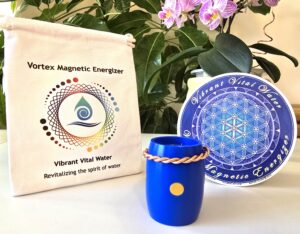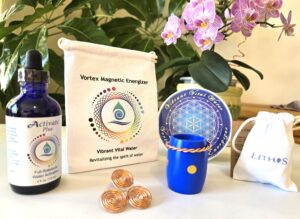Description
NEW Earth Resonance Tensor Ring!
Tensor Rings generate torroidal vortices similar to a smoke ring. They also produce a tensor field across the opening of the ring, much like the thin film that stretches across a loop when it is removed from a soapy solution. Tensor Rings create a column of energy that reaches for some distance on both sides of the ring. The energetic column has the capacity to organize the space within the column. This includes organizing the molecular structure of water. When water is passed through a Ring, its molecular structure becomes more organized. The longer it sits inside the column, the more refined the structure becomes. Tensor Rings have an extremely high paramagnetic value, capable of spinning the ORMUS elements into their high spin state. This enhances the energetic value of water and helps it to hold its structure.
NOTE: The Earth Resonance Tensor Rings is made using measurement that is tuned to the Earth’s central core and to the Earth’s natural energy field. They re-connect water (and anything placed in their energetic field ) to the core energy of the Earth. This cubit length is extremely grounding and protective for water.
—————————————————————————————————————————————————————-
Tensor Ring Technology, developed by Slim Spurling and Bill Reid in the 1990s, is supported by exciting research. Originally called Light-Life™ Rings, they are now also known as Tensor Rings. Tensor Rings create a toroidal vortex—a region of rotating movement where the flow takes on a toroid (doughnut) shape. Examples of this phenomenon are smoke rings and bubble rings. Toroidal vortices are produced by dolphins, and whales, in the ocean. They can be seen playing with them for extended periods of time before they dissipate.
Anytime you create a loop—regardless of the material—a tensor network is created in the opening of the loop. This network is a mathematical expression of a concept developed by physicist John Wheeler who worked on the Manhattan Project. According to Wheeler, if you could see a tensor network, it would resemble the thin film that forms when a loop is dipped in a soapy liquid. Slim and Bill referred to the opening of the Ring as a tensor field and suggested that it was more than a mathematical expression. They felt that a “tensor field” was partly the reason soapy liquid created the film inside any looped material. They felt that the liquid actually “clung” to the energetic field within the loop. The term tensor network is used today to understand complex systems made of many different interacting parts. It is considered by some to have geometry much like space-time.

Those who perceive subtle energy describe a beam of light within a Tensor Ring that extends in both directions. The energetic column appears to organize the space within. As water passes through a Tensor Ring, its molecular structure becomes more organized; the longer it sits inside the column, the more refined the structure becomes. Tensor Rings can be used around a container of water, around faucets, showerheads or the incoming water line. As the structure of the water becomes more organized, chlorine is released and the taste of the water generally improves. Other improvements that are more difficult to quantify, augment water’s energy. Because of the column of energy that is created by a Tensor Ring, it is one of the most useful devices for protecting water from the effects of unnatural electromagnetic fields (EMFs) and other outside influences. It is often used to add or preserve the “information” that is imprinted to water.
One of the ways Tensor Rings augment water’s energy is through the influence of paramagnetism. Phillip Callahan, an expert on paramagnetism, noted that Tensor Rings exhibit a paramagnetic value many times greater than anything ever tested. According to Callahan, paramagnetism amplifies the Earth’s resonance. It may also cause some of the elements in water to spin to their high-spin state referred to as ormus. This can have an impact on water’s molecular structure and on the overall energy of the water. Evidence for the presence of ormus can be seen in this experiment: Place two equal volumes of water in identical containers on a balance scale so that they are equally balanced. Place a Tensor Ring directly over one container. After 48 hours, the container with the Ring above it becomes measurably lighter (the difference in weight is dependent on the type and amount of minerals or salts in the water that can enter a high-spin state). Chapter 3 in the second edition of Dancing with Water discusses how the high-spin state (ormus) can reduce an element’s weight.
In addition to their effect on water, Tensor Rings have been used to augment plant growth and vitality. They are often used to reduce pain and inflammation. No health claims are being made, however, if Rings “organize the space” create coherence within their energetic column, it would explain their ability to reduce inflammation and their ability to support the healing response. Although short-term use on the body can be beneficial, their long-term use in one place is not recommended. For this reason it is not recommended that they be worn as bracelets or pendants, or over the head for a long period of time.
When the ends of a conductive wire are brought together, a circuit is completed and an energetic field emerges. Although this circuit is not technically electric, it does have electrical properties; when placed “in” water, those properties are enhanced. Tensor Rings placed in water have a subtle electrolytic effect. In other words, the energetic circuit begins to gently ionize water; this process releases tiny (often monoatomic) particles from the wire. Many colloidal preparations are made using electrolysis, where two metal electrodes are suspended in water while direct current is applied. For this reason, it is not suggested that copper Tensor Rings be placed in water

Tensor Rings are most often used as a single unit (placed around a pitcher of water, over a faucet, or around a water line), but they can be used in groupings with interesting effects. When placed in series (shown right) their energetic columns overlap to create a stronger, expanded field. This setup is ideal for placement on an incoming water line.
Credit to: MJ Pangman, “Dancing with Water”







Reviews
There are no reviews yet.